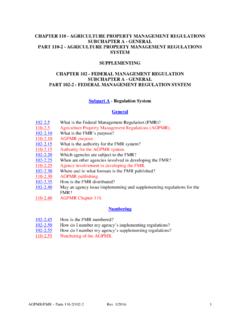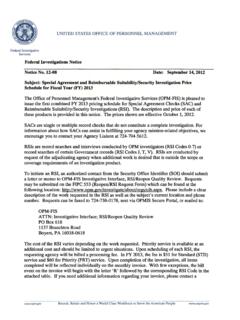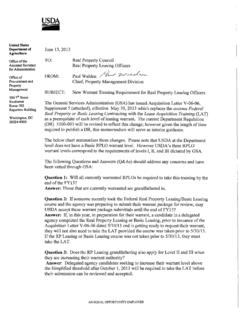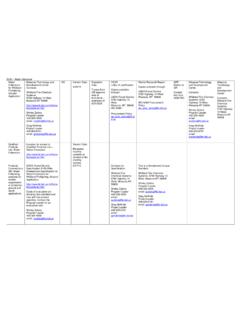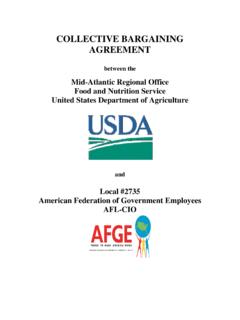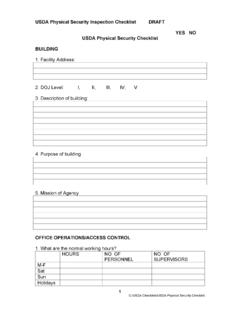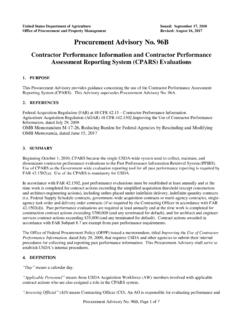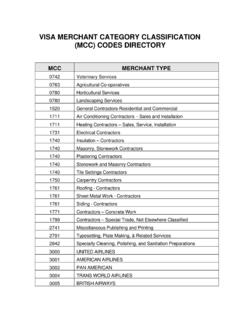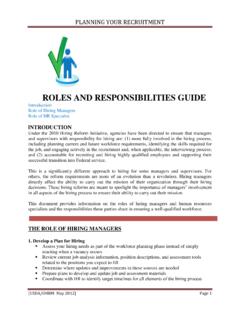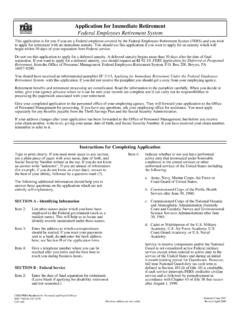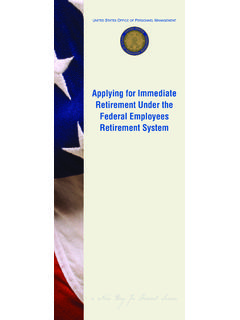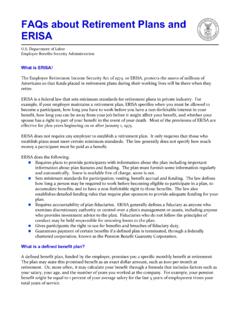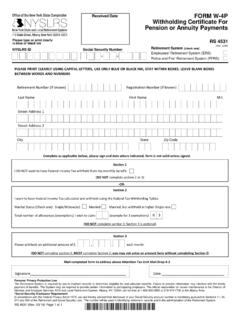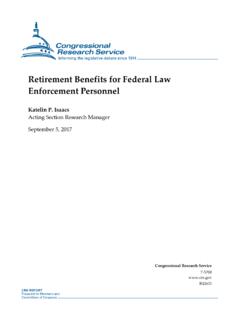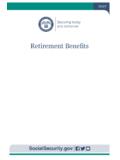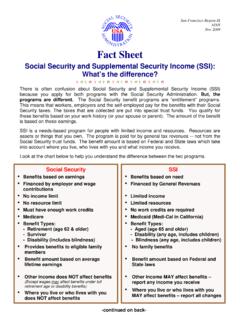Transcription of Federal Employees Retirement FERS System - USDA
1 Federal Employees Retirement System FERSThis document contains highlights of the Federal Employees Retirement System (FERS). It is not intended to provide a detailed explanation of all the plan provisions or exceptions. The information is based on the Aprilinformation available at the time. Additional information is available at , and March 2016 1 Introduction Most people look forward to Retirement as a rewarding time. But, a rewarding Retirement doesn t just happen. In takes careful planning. Knowing when you can retire and understanding your Federal Retirement benefits are an important part of the planning process. Your future financial security depends, in part, on the decisions you make today. The Federal Employees Retirement System (FERS) covers most new, non-temporary Employees hired on or after January 1, 1984.
2 FERS is a Retirement System that is responsive to the employee s needs and decisions. Many of its features are portable, so if you leave Federal employment, you may still qualify for the benefits. FERS enables you to take an active role in securing your future. Therefore, it is important for you to understand the features and benefits of the Retirement program, so you can make wise financially sound decisions now in preparation for your Retirement . This booklet highlights the main features of the Federal Employees Retirement System (FERS). The US Department of Agriculture ( usda ) provides you with a Personal Benefit Statement highlighting your employee benefits coverage and costs. The benefits statement is located on the Employee Personal Page (EPP) and is updated annually. This is an excellent document to keep with your will or to take with you to your personal financial planner as a planning tool for the future.
3 Components of your Retirement FERS is a three-tiered Retirement System , providing Retirement income from three separate sources. The three components are: FERS Basic Annuity Thrift Savings Program (TSP) Social Security Benefits These three components work together to provide you a strong financial foundation for your Retirement years. 2 FERS Basic Annuity Plan Coverage under the FERS basic annuity plan is determined by when and how you were hired. New Employees first hired in permanent or TERM positions on or after January 1, 1984 are covered under the FERS Retirement System . You should verify your Retirement coverage by reviewing your Personal Benefits Statement on EPP, reviewing your Earnings and Leave Statement, or reviewing your Notification of Personnel Action, Standard Form (SF) 50, block 30.
4 You can locate the SF-50 form in your electronic Official Personal Folder (eOPF). If you have any questions about how to locate and review your eOPF, contact your servicing HR office. In Block 30 of the SF-50 the following Retirement codes indicate a FERS Retirement plan: Potential FERS Retirement Plans K FERS and FICA ( Federal Insurance Contributions Act (Social Security)) KR FERS-RAE (Revised Annuity Employees ) and FICA KF FERS-FRAE (Further Revised Annuity Employees ) and FICA M FERS and FICA Special (for Firefighter and Law Enforcement Officers) MR FERS-RAE and FICA Special (for Firefighter and Law Enforcement Officers) MF FERS-FRAE and FICA Special (for Firefighter and Law Enforcement Officers) Sample of center section of SF-50: Why are there so many different Retirement codes for FERS?
5 The different Retirement codes indicate different payroll deduction percentage amounts. The difference is determined by when you were hired and the type of position you were hired into. For example, firefighters and law enforcement officers must pay a .5% higher contribution towards Retirement because they can retire earlier than most Employees and have a mandatory Retirement age of 57. In addition, in 2013 and 2014 Congress increased the Retirement contribution percentages for new Employees . This also resulted in new Retirement codes for the different contribution rates. 3 FERS Contribution Rates: Category Retirement Code Employee Contribution Agency Contribution Applicable Hire Years FERS Regular Employees K .8% 1984-2012 FERS-Special Firefighters & Law Enforcement Officers M 1984-2012 FERS-RAE Regular Employees KR 2013 FERS-RAE - Special Firefighters & Law Enforcement Officers MR 24% 2013 FERS-FRAE Regular Employees KF 2014 present FERS-FRAE - Special Firefighters & Law Enforcement Officers MF 2014 - present Note: If you had breaks in service your Retirement codes may be different than listed above.
6 If you have questions or concerns about your Retirement code, do not hesitate contacting your benefits specialist in your servicing HR office for verification. Key Point: Because there are many different Retirement codes and deduction rates, each employee should verify the Retirement code on their SF-50 appears accurate AND the contribution rate is correctly deducted on their Earnings and Leave Statement. Simply multiple your gross pay by the corresponding employee contribution percentage above. If there is an error or a concern, please call your servicing HR office. Creditable Service for Retirement Creditable service means the amount of service used to calculate your Retirement eligibility or your Retirement annuity. Years and full months of creditable service are added together and used in the Retirement calculation.
7 To determine your length of service for computation, add all of your periods of creditable service, then eliminate from the total any fractional part of a month (less than 30 days). Service that may be creditable towards Retirement generally includes: Federal civilian service for which contributions have been made or deposited. Military service, if a deposit is complete. To receive credit for military service, generally, you must deposit 3% of your military base pay. Interest begins to accrue 2 years after you are hired. With certain exceptions, you cannot receive credit for military service if you are receiving military retired pay. National Guard service is normally not creditable, 4 except when ordered to active duty in the service of the United States. However, there are rare circumstances when you may receive credit for National Guard service after August 1, 1990, if it is followed directly by Federal civilian reemployment.
8 If you think this provision applies to you, please contact a Benefits Specialist at your servicing HR office. Leaves of absence for performing military service or while receiving workers compensation. Unused sick leave. (Sick leave is creditable for the annuity computation only. Sick leave cannot be used to determine Retirement eligibility.) Non-deduction service prior to 1/1/1989, if a deposit is made. Service Computation Dates The Service Computation Date (SCD) determines an employee s eligibility for a specific benefit or entitlement. There are four different types of SCDs: Leave, Retirement , Thrift Savings Plan, and Reduction-In-Force (RIF). Leave SCD determines the amount of annual leave earned per pay period: four, six, or eight hours. It is shown in block #31 of the Standard Form (SF) 50.
9 This SCD includes most military service, unless you are retired military, even if you haven t made the military deposit. The rules of computing this SCD are found in the Guide to Processing Personnel Actions, Chapter 6. Note: Only your Leave SCD appears on the SF-50. TSP SCD is used to determine when you become vested in TSP. Vesting means that you are entitled to keep your Agency Automatic (1%) Contributions (and their earnings) after you ve completed a time-in-service requirement. Most FERS Employees are vested in TSP after 3 years of service. All Federal civilian service time is included in this SCD. RIF SCD is one of the factors used to determine an employee s retention if there was a Reduction in Force at the agency. 5 Retirement SCD includes the service that is creditable in determining if you are eligible for Retirement .
10 Your Retirement SCD is often the date when you were first covered under FERS. The Retirement SCD may be adjusted if a deposit is made for non-deduction service before 1989 or military service. The Retirement SCD is used to determine Retirement eligibility and therefore, does not include sick leave. Sick leave is used in the Retirement annuity computation, but not to determine eligibility for Retirement . Time not creditable for Retirement that may affect the Retirement SCD: Excess leave without pay (LWOP) Federal service requiring a deposit that has not been paid Temporary service performed after 1989 (FERS only) Breaks in Federal service in excess of three days Military service with an unpaid deposit Vesting in FERS Vesting means you have a current or future right to receive a FERS basic annuity.
